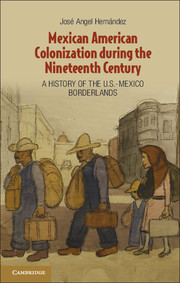 Mexican American Colonization during the Nineteenth Century
Mexican American Colonization during the Nineteenth Century The Prehistory of Revolt
Published online by Cambridge University Press: 05 June 2012
INTRODUCTION
The repatriation of the Mexican populace, as we have read in previouschapters, occurred largely from the 1830s to the 1850s, but by the 1870s thefederal government had seemingly forgotten how to foment a viablecolonization program. Once the earlier projects of the postwar period wereimplemented and executed, the Mexican government, according to the state oficials searching for federal laws to grant lands, did not continue applyingthe postwar lessons of a colonization law that addressed the particularitiesof Mexican American colonization, at least not until the period from 1875 to1883. The case of La Ascensión may serve as a microcosm into the innerworkings of how Mexico went about settling colonies along the northernfrontier during the 1870s.
Letters requesting repatriation to Mexico are few and far between during theperiod between 1855 and 1875, due primarily to the ongoing wars against theIndios Bárbaros and, according to government officials,“administrative disorder.”” Not until the Porfirian period dowe see an increase in repatriation requests, perhaps inl uenced in largemeasure by the case of La Ascensión, including an increase inadvertisement of the law proper. Moreover, the case of La Ascensióninfluences the foundation of the 1883 Land and Colonization Law thatestablished the first modern colonization program outlining preferentialtreatment for the Mexican American population residing outside of thecountry. La Ascensión was a watershed in terms of actually implementingand administering a repatriation policy, and ultimately forced thegovernment to pass legislation concerning the colonization process.
To save this book to your Kindle, first ensure no-reply@cambridge.org is added to your Approved Personal Document E-mail List under your Personal Document Settings on the Manage Your Content and Devices page of your Amazon account. Then enter the ‘name’ part of your Kindle email address below. Find out more about saving to your Kindle.
Note you can select to save to either the @free.kindle.com or @kindle.com variations. ‘@free.kindle.com’ emails are free but can only be saved to your device when it is connected to wi-fi. ‘@kindle.com’ emails can be delivered even when you are not connected to wi-fi, but note that service fees apply.
Find out more about the Kindle Personal Document Service.
To save content items to your account, please confirm that you agree to abide by our usage policies. If this is the first time you use this feature, you will be asked to authorise Cambridge Core to connect with your account. Find out more about saving content to Dropbox.
To save content items to your account, please confirm that you agree to abide by our usage policies. If this is the first time you use this feature, you will be asked to authorise Cambridge Core to connect with your account. Find out more about saving content to Google Drive.